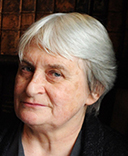Sir Misha Black Award for Innovation in Design Education
Professor Sir Christopher Frayling who represents the College of Medallists on The Awards Committee, read the citation for Catherine McDermott:
“Next week, on the 24th of November, the Design Museum will be reopening its doors in a wonderful new location — the refurbished and redesigned Commonwealth Institute building just down the road at Holland Park — an event which aims to do for design what the opening of Tate Modern did for contemporary art in the year 2000. And this is a great cause for celebration.
But there’s another, related, cause for celebration — less loudly trumpeted and still very significant. And that is the fifteenth birthday of the joint course between the Design Museum and Kingston University on ‘Curating Contemporary Design’, which was validated in the year 2000 and which enrolled its first students in 2001. Tonight’s Misha Black award for design education shines a well-deserved spotlight on that increasingly influential course — and on the person who has conceived, steered, directed and taught it from the very beginning — Catherine McDermott of Kingston University.
The journey of design from the wings to the centre of the stage over the last quarter-century has been accompanied by the parallel growth of the infrastructure to support it — museums or parts of museums, galleries, exhibitions, publications, catalogues, journals and articles in newspapers and online. And Catherine’s course has successfully fed these developments — educating curators, writers, interpreters, ambassadors and entrepreneurs. Not just in the UK, but overseas as well—through a network of alumni in—at the last count — Tokyo, Seoul, Beijing, Mexico City, Cape Town and most of the European capitals. You could draw a map of today’s design culture which would show where Catherine’s graduates have ended up—and it would resemble one of those busy charts in the Cabinet War Rooms, with lots of arrows pointing all over the world.
Catherine herself was one of the pioneers of design history and design criticism — from way back in the late 1970s when the subject was still in its rather volatile infancy. As I knew from my own experience, she took part in the planning of the RCA’s joint postgraduate course with the V&A on the history of design which was launched in 1981 — an earlier partnership of university and museum, and not at all easy to achieve. In the 1980s,’90s and 2000s Catherine published books on essential design, modern design, twentieth-century design, design – the key concepts, made in Britain, street style – design in the 1980s as well as monographs on Vivienne Westwood, Ben Kelly and others. A one-person encyclopaedia of design, who curated exhibitions on everything from modern furniture to Princess Diana. And addressed more conferences than any of us will care to remember — including her, I suspect.
Catherine the Great — if I may call her that — has always led from the front.
It was in the 1990s that she spotted an opportunity, a gap in the educational market nationally and internationally — for a course in Curating Contemporary Design. There were numerous courses on curating contemporary art, or curating the history of art or museology — something of a growth industry in the 1990s—but none at all on curating contemporary design — and for this, what better partnership could there be than with the Design Museum, at Butler’s Wharf — under its then-Director the young Paul Thompson, now of this parish.
As the museum’s principles and practices matured, so did the joint course. The course leader at the Design Museum end, making sure the linkage worked smoothly in every way, has for many years been Donna Loveday, who is one of our guests tonight. She’s the head of curation at the Museum.
Misha Black was a passionate campaigner for enhancing the public understanding of design, and for establishing standards in the appreciation of design —and I’m certain he would have been delighted by the ways in which the joint course has contributed to both over the past fifteen years. He once observed that ‘good wine needs no bush (meaning: there's no need to boast about good quality — it will advertise itself) — but that doesn’t mean that good design needs no push. It does.
Catherine has already been awarded a National Teaching Fellowship for her work on developing the programme. Tonight, we add to that — on her crowded mantelpiece — a Misha Black award for innovation in design education, for what she has now achieved with the programme.
Ladies and gentlemen, Catherine McDermott.”
–––––
Professor Malcolm Garrett RDI who represents the RSA Faculty of Royal Designers for Industry on The Awards Committee, read the citation for Arts University Bournemouth:
“I really should start by giving some background to the second recipient of a Sir Misha Black Award this year.
This institution has embraced a coming together over the years of a rather broad range of educational strands, bringing it from its inception over 135 years ago, to the point at which we celebrate its achievements this evening.
The Arts University Bournemouth of today has steadily evolved, from one of the many specialist arts institutions that were formed during the early part of the 20th century. It grew initially from the first art school, the Bournemouth Government School of Art, which had been established in 1880, and in the years since has continued to develop and grow as an outstanding further and higher education institution, specialising in art, performance, design, and media.
Having until recently been first The Arts Institute at Bournemouth – from 1998 – and then from 2009 The Arts University College at Bournemouth – when it acquired powers to award external degrees – it finally satisfied the criteria for full University status and adopted the name Arts University Bournemouth in December 2012. And the gradual expansion and increase in the number of students, to almost 3000 in 2016, has enabled the university to become fully independent and establish itself as one of the finest schools of art in the country.
Throughout what has undoubtedly been a lengthy gestation and evolutionary period, central to that evolution has been a focus on developing and maintaining the highest standards of arts and creative education, and AUB can now boast the highest percentage, – at 97.4% – of graduates entering employment and further study within six months of graduation – higher than any other university in the United Kingdom.
Instrumental in this growth and repositioning as the Arts University Bournemouth, is Professor Stuart Bartholomew who joined in 1997 as Principal and Vice Chancellor.
Since being appointed he has led the School of Art through the many stages necessary to fulfil the needs of a multi-subject university. Its current status, and the level of expertise at which the college now operates, reflects not only his vision and stewardship, but also his ongoing involvement in the broader concerns of the Higher Education Sector, and most importantly the skills and support of the fantastic team that he has surrounded himself with … some of whom are with us this evening…
Since 1997 Stuart has overseen a number of radical enhancements to the university’s facilities and its teaching programme, arguably the most innovative and exciting of which is the integration of teaching and creative practice at the university, with a public-facing programme of community-driven exhibitions and projects.
A programme of building which Professor Bartholomew has continued, began with the first new building on the present campus which was opened in 1984. Later TheGallery was founded in 2003 and with ongoing development was formally re-opened in 2010.
A unique space for arts in the South East and West, TheGallery showcases work from contemporary artists and designers, with a supporting programme designed to respond to each exhibition and enrich the learning, teaching and research practice undertaken at the university, and to forge partnerships between artists, writers and critics.
The highly-acclaimed Drawing Studio, designed by Bournemouth School of Art alumnus Sir Peter Cook, opened its doors to students this year. It is the first purpose-built drawing studio to open in the UK for 100 years, and recognises the fundamental nature of drawing and the way in which it stimulates creative thought. Emphasising natural light and featuring a large circular north-light and a rear clerestory, which provides the softer light that is most conducive to observation, the act of drawing becomes a calm and considered activity within the lively world of a very busy and creative institution.
This iconic pavilion was shortlisted for the 2016 RIBA South West Awards, but most significantly the Drawing Studio has been praised by students as a refreshing and inspiring addition to the campus. It is an oasis of creativity shared by students across all disciplines.
Of course, the Sir Misha Black Award is not only given for commissioning innovative architecture such The Gallery and Drawing Studio but for excellence in teaching in all areas including animation, model making and photography. Work of graduates on these courses, as well as those on costume, theatre and film design have received international recognition.
Celebrated alumni include one of my own favourites, the critically acclaimed photographer, and Turner Prize Winner, Wolfgang Tillmans, who graduated from Bournemouth and Poole College of Art and Design, as it was then, in 1992.
I’d like to conclude with an eye-watering and heart-warming quote from an alumnus of the RCA and a Patron of AUB, someone you will all be familiar with – for it was David Hockney, who said... “Drawing makes you see things clearer, and clearer, and clearer still, until your eyes ache.”
So it is not so much with aching eyes, but definitely with warm heart, that I’m delighted to announce that the second Sir Misha Black Award for Innovation in Design Education this evening is to be awarded to Arts University Bournemouth.”




